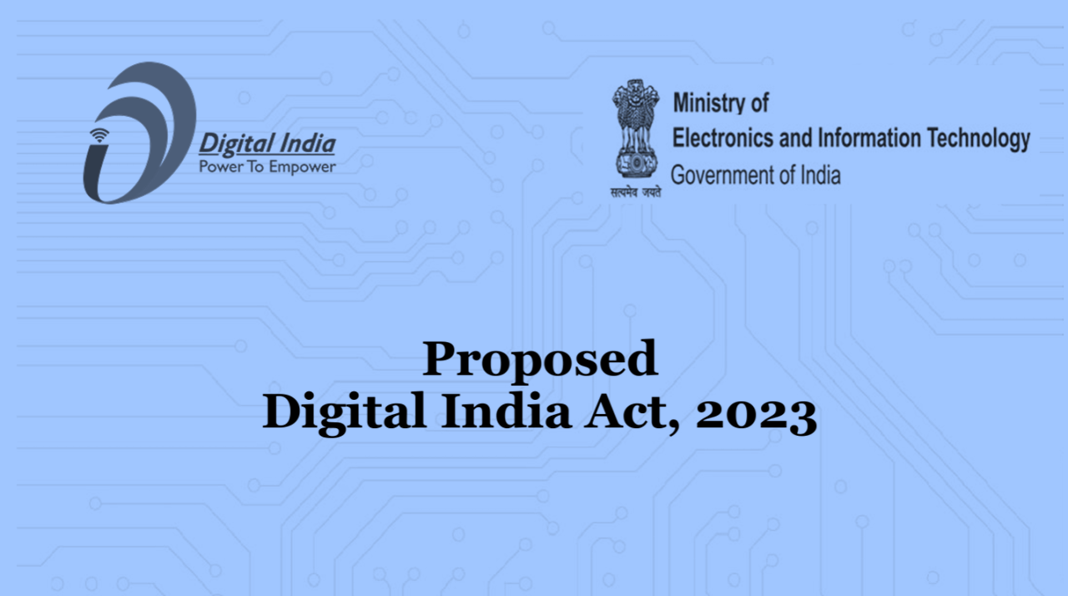Description

Copyright infringement not intended
Picture Courtesy: www.linkedin.com
Context: The Digital India Act 2023 (DIA) announcement by the Ministry of Electronics and Information Technology (MEITY) reflects India's proactive stance in establishing a modern legal framework for its rapidly expanding digital landscape. This represents a significant step towards regulating and shaping India's digital future.
Details
- The digital revolution has transformed the world in unprecedented ways, creating new opportunities and challenges for individuals, businesses, and governments. The rapid growth of digital technologies and platforms has also raised new legal and ethical issues, such as data protection, cybersecurity, digital rights, and digital inclusion.
- To address these issues and harness the potential of the digital economy, India has embarked on an ambitious initiative called ‘Digital India’, which aims to provide universal access to digital infrastructure, services, and governance.
- One of the key components of the Digital India initiative is the Digital India Act 2023 (DIA), which was recently announced by the Ministry of Electronics and Information Technology (MEITY). The DIA is a comprehensive legislation that seeks to establish a robust legal framework for the country’s digital ecosystem, covering various aspects such as data privacy, cybersecurity, digital identity, e-commerce, digital literacy, and digital innovation.
- The DIA is expected to be tabled in the Parliament in the upcoming session and will replace several existing laws and regulations that are outdated or inadequate for the current digital scenario.
Features of the Digital India Act 2023 (DIA)
- Adaptation to the Digital Revolution: The DIA acknowledges the substantial growth of India's internet user base and the evolving nature of internet usage. By replacing the Information Technology Act of 2000, which was designed for a different era, it aims to create a legal framework that aligns with the digital revolution of the 21st century. This is crucial to effectively regulate and address the challenges and opportunities posed by emerging technologies.
- Online Safety and Trust: The DIA places a strong emphasis on online safety and trust. It seeks to safeguard citizens' rights in the digital realm and address various forms of user harm such as cyberstalking, trolling, and doxing. This provision is critical in creating a safer online environment for Indian citizens.
- Guidelines for New-Age Technologies: The DIA provides guidelines for the responsible utilization of new-age technologies like artificial intelligence and blockchain. By doing so, it encourages innovation while ensuring ethical and legal compliance. This proactive approach positions India as a responsible player in the global technology landscape.
- Balancing Accessibility and Regulation: The legislation aims to strike a balance between providing an open internet and implementing necessary regulations to maintain order and protect users. This balance is essential to promote freedom of access while addressing potential harms and abuses.
- Know Your Customer (KYC) for Wearable Devices: The DIA mandates stringent KYC requirements for wearable devices, which is essential for ensuring data security and privacy in the growing wearables market.
- Review of Safe Harbour Principle: The contemplated review of the "safe harbour" principle for online platforms signals a potential shift in online accountability standards. This could have significant implications for how online platforms handle user-generated content and their liability.

DIA faces several challenges and hurdles in its implementation
- Coordination: The DIA involves multiple ministries, departments, agencies, bodies, etc. that have different roles and responsibilities in the digital domain. There is a need for effective coordination and collaboration among these entities to ensure the smooth functioning and alignment of the DIA with the overall objectives and goals of the Digital India initiative.
- Capacity: The DIA requires adequate human, technical, and financial resources to execute and enforce its various provisions and clauses. There is a need to build and enhance the capacity of various entities involved in the DIA, to ensure their efficiency and effectiveness.
- Awareness: The DIA affects various stakeholders such as individuals, businesses, governments, etc. who have different rights, obligations, and interests in the digital domain. There is a need to create awareness and sensitization among these stakeholders about the DIA and its implications for them. There is also a need to solicit feedback and inputs from these stakeholders to ensure that the DIA is inclusive and responsive to their needs and expectations.
- Compliance: The DIA imposes various rules and regulations on various entities involved in the digital sector, such as data fiduciaries, data processors, cybersecurity service providers, e-commerce platforms, etc. There is a need to ensure compliance and adherence to the rules and regulations of these entities. There is also a need to monitor and evaluate the performance and impact of these rules and regulations on the digital sector and its stakeholders.
- Adaptability: The DIA is designed to address the current and emerging issues and challenges in the digital domain. However, the digital domain is constantly evolving and changing due to technological advancements, market dynamics, user preferences, etc. There is a need to ensure that the DIA is adaptable and flexible to accommodate these changes and developments in the digital domain.
Some of the possible ways forward
Strengthening the DIC (Digital India Corporation)
- Independence: The DIC should be given operational independence to carry out its functions without undue influence from external parties. This ensures that its decisions and actions are guided solely by the best interests of digital users and businesses.
- Transparency: The DIC should operate with transparency, making its activities, decisions, and processes open to public scrutiny. This transparency can help build trust and confidence among stakeholders.
- Accountability: Establish clear lines of accountability within the DIC to ensure that it is held responsible for its actions and decisions. This can include reporting mechanisms and regular audits.
- Monitoring and Enforcement: Equip the DIC with the necessary tools and resources to effectively monitor compliance with DIA and related policies and enforce them when violations occur.
Engaging Stakeholders
- Regular Consultation: Establish a structured framework for regular consultation and dialogue with all relevant stakeholders, including digital service providers, businesses, civil society organizations, and consumers. This will ensure that their concerns and suggestions are considered in the policymaking process.
- Transparency in Decision-Making: Make the policymaking process more transparent by publishing draft policies for public comment and feedback. This allows stakeholders to provide input and express their concerns.
Promoting Digital Literacy and Awareness
- Education and Training: Implement educational programs and campaigns to enhance digital literacy among users and businesses. This includes educating people about their rights and responsibilities in the digital realm.
- Information Dissemination: Develop clear and accessible information resources, such as websites, brochures, and online guides, to inform users and businesses about DIA and related policies.
- Consumer Protection: Empower consumers with knowledge about how to protect themselves online and what recourse they have in case of digital fraud or abuse.
Investing in Digital Infrastructure
- Universal Access: Ensure that digital infrastructure is available in even remote and underserved areas of India to achieve universal access to the internet and digital services.
- Affordability: Promote policies that make digital services affordable for all, including subsidies and incentives for low-income individuals and businesses.
- Quality and Reliability: Invest in the improvement of digital infrastructure to enhance the quality and reliability of services, reducing downtime and ensuring a seamless digital experience for users.
Encouraging Innovation and Competitiveness
- Research and Development: Foster a culture of research and development in the digital sector by providing grants, funding, and incentives for innovation.
- Entrepreneurship: Support startups and small businesses in the digital space through incubators, accelerators, and favourable regulatory environments.
- Collaboration: Encourage collaboration between academia, industry, and government to drive innovation and competitiveness in the digital sector.

Conclusion
- The Digital India Act 2023 is a significant step forward in shaping India's digital future. It addresses the evolving digital landscape, promotes responsible technology adoption, and aims to create a safer and more accountable digital environment. However, the success of the DIA will depend on how it is implemented and adapted over time to address potential challenges and unintended consequences in the ever-changing digital arena.
Must Read Articles:
Digital India Programme: https://www.iasgyan.in/daily-current-affairs/digital-india-programme
Digital India Act: https://www.iasgyan.in/daily-current-affairs/digital-india-act-11
|
PRACTICE QUESTION
Q. What are the key challenges that Digital India faces in achieving its goal of transforming India into a digitally empowered society and knowledge economy, and how can these challenges be effectively addressed?
|















